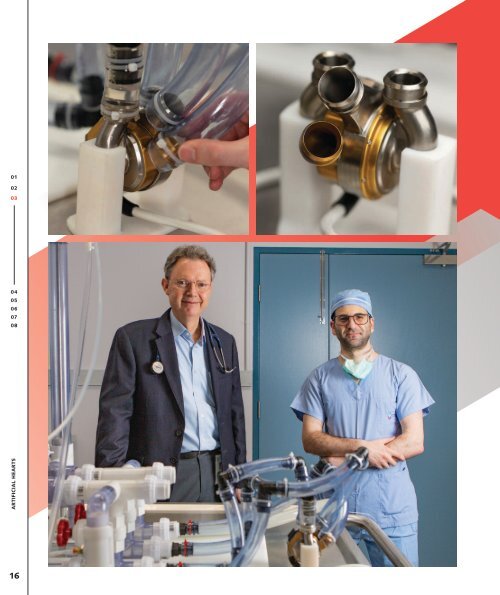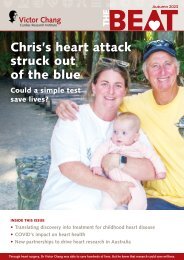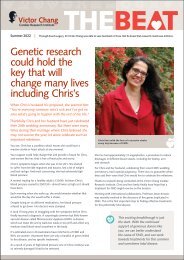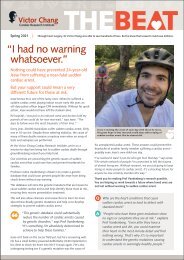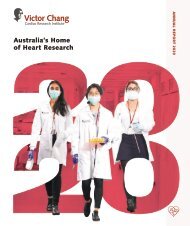Victor Chang Cardiac Research Institute 2021 Annual Report
The 2021 Victor Chang Cardiac Research Institute Annual Report is an edition reflecting on the year that was - a year where the Institute is laying the foundations and reinforcing their voice as the leaders in cardiovascular translational research across Australia.
The 2021 Victor Chang Cardiac Research Institute Annual Report is an edition reflecting on the year that was - a year where the Institute is laying the foundations and reinforcing their voice as the leaders in cardiovascular translational research across Australia.
You also want an ePaper? Increase the reach of your titles
YUMPU automatically turns print PDFs into web optimized ePapers that Google loves.
THE BIVACOR<br />
HEART<br />
01<br />
02<br />
03<br />
ONLY 6,000 DONOR HEARTS WORLDWIDE<br />
ARE AVAILABLE EACH YEAR, A VERY<br />
SMALL NUMBER WHEN COMPARED<br />
TO THE OVERWHELMING NEED<br />
04<br />
05<br />
06<br />
07<br />
08<br />
ARTIFICIAL HEARTS<br />
The BiVACOR total artificial<br />
heart can replace the function<br />
of the failing heart. It’s smaller,<br />
more powerful, more responsive,<br />
and more durable than existing<br />
devices on the market.<br />
It’s designed to be implanted in<br />
place of a human heart to support<br />
patients with end-stage biventricular<br />
heart failure (both sides of the heart<br />
not working adequately).<br />
The pump has several unique features:<br />
The motor is magnetically suspended<br />
within the device, which reduces<br />
wear and tear, minimises effects on<br />
blood cells, and enhances durability.<br />
The motor has a dual impeller<br />
design that supports both the left<br />
and right sides of the pump – this<br />
reduces potential points of failure.<br />
Finally – despite continuous flow<br />
technology, the motor can mimic<br />
the pulsatile heart by increasing<br />
or decreasing the pump speed<br />
to create a pulse wave.<br />
Whilst initial trials will focus on<br />
patients who require a bridging device<br />
to transplant, it’s been designed to<br />
provide more than 10 years of support<br />
and it’s hoped it will replace the need<br />
for donor heart transplantation for<br />
many patients around the world.<br />
THE INSTITUTE’S<br />
PIVOTAL ROLE<br />
A team at the <strong>Victor</strong> <strong>Chang</strong> <strong>Cardiac</strong><br />
<strong>Research</strong> <strong>Institute</strong> and St Vincent’s<br />
Hospital, Sydney – led by the <strong>Institute</strong>’s<br />
Professor Hayward – is preparing<br />
this incredible device for its first<br />
human trials.<br />
They are trialling it on a mock<br />
circulatory loop – a machine that<br />
mimics the human cardiovascular<br />
system where they can adjust the<br />
parameters of the system to mimic<br />
all sorts of cardiovascular states<br />
including heart failure and see<br />
how the pump affects the rest<br />
of the vascular system.<br />
The team is also placing the device<br />
in 3D models of the human chest<br />
to see how much pressure it exerts<br />
on the back of the chest wall.<br />
Professor Hayward is working<br />
closely with BiVACOR’S Australian<br />
founder, Dr Daniel Timms, and<br />
is part of a worldwide collaboration<br />
working on this project.<br />
victorchang.edu.au<br />
Top left and top right: The BiVACOR heart<br />
Bottom: Prof Chris Hayward and Dr Sam Emmanuel<br />
16<br />
17


